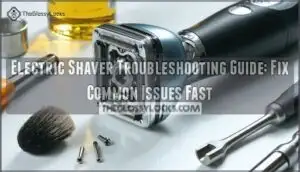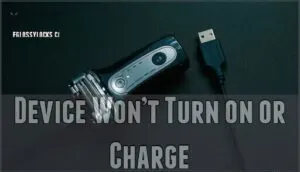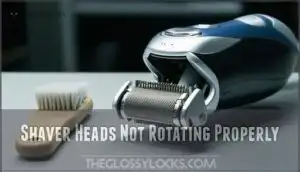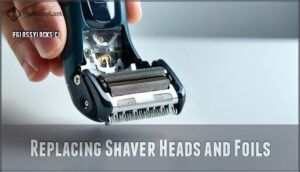This site is supported by our readers. We may earn a commission, at no cost to you, if you purchase through links.

If it won’t turn on, try holding the power button for ten seconds to reset it. Dull blades often cause tugging and poor performance, so consider replacing them if they’re over 18 months old.
For skin irritation, use less pressure and make sure you’re shaving with proper technique. Most electric shaver troubleshooting guide issues stem from simple maintenance problems rather than serious mechanical failures that require professional repair.
Table Of Contents
- Key Takeaways
- Common Reasons for Electric Shaver Failure
- Troubleshooting Electric Shaver Performance
- Solving Skin Discomfort and Shaving Issues
- Essential Shaver Maintenance Tips
- When to Seek Expert Help or Replacement
- Frequently Asked Questions (FAQs)
- How do you troubleshoot an electric shaver?
- Why is my electric shaver not working?
- How do I know if my electric shaver is good?
- How do you maintain an electric shaver?
- Should you use an electric shaver?
- Do electric shavers need maintenance?
- Why do electric shavers stop working?
- Why does my electric razor keep cutting out?
- Why does my electric shaver miss hairs?
- What is the life expectancy of an electric shaver?
- Conclusion
Key Takeaways
- Start with the basics when troubleshooting – Check if your shaver’s charged, inspect the charging cable for damage, and clean the shaver heads thoroughly, as dead batteries and clogged heads cause most problems.
- Replace blades every 12-18 months – You’ll notice tugging and poor performance when blades get dull, and this simple replacement solves most cutting issues rather than requiring expensive repairs.
- Use proper shaving technique – Apply light pressure and let the shaver do the work, since excessive pressure causes razor burn, skin irritation, and uneven results.
- Maintain your shaver regularly – Clean after every few uses, store it properly in a dry place, and follow the manufacturer’s maintenance schedule to prevent most problems before they start.
Common Reasons for Electric Shaver Failure
Your electric shaver can fail for several common reasons that you can easily identify and fix yourself. Dead batteries, damaged charging cables, dull blades, and improper assembly after cleaning account for most shaver problems you’ll encounter.
Low or Dead Battery Issues
The most frustrating moment? Your shaver won’t turn on when you need it most. Battery issues cause over 15% of electric shaver problems, but they’re often the easiest to fix.
- Check charging indicators for battery status and power connection
- Charge for at least 2 hours using the original power adapter
- Clean battery contacts to remove contact corrosion buildup
- Test with different outlets to rule out charging issues
- Consider battery replacement if power issues persist despite proper charging
Most electric shaver batteries last somewhere between 3 to 7 years, depending on how often you use them.
Damaged Charging Cables and Adapters
Your charging cable might be the culprit behind power issues. Check for visible damage like frayed wires or bent connectors. Try a different outlet to rule out electrical problems.
If your adapter’s voltage doesn’t match what your shaver needs, it won’t charge properly.
Check your shaver’s manual or look for the voltage specs printed on both devices to make sure they’re compatible.
Store your power cord properly to avoid kinks. Test charging alternatives like USB ports if available. Faulty connections often cause intermittent charging problems.
Dull Blades and Foil Problems
You’ll notice shaving discomfort and performance degradation when blades and foils wear out. Dull blades tend to pull your hair rather than cut it, leading to discomfort and irritation.
Stick to a replacement schedule: most manufacturers recommend swapping out foils every 12-18 months. Keep an eye out for warning signs like blades that tug at your hair instead of cutting cleanly, or shaves that just don’t feel as smooth as they used to.
If you’re shaving daily, you’ll likely need fresh blades before that 18-month mark hits.
To keep your shaver in top condition, consider regular lubrication of blades.
Improper Assembly After Cleaning
After replacing old blades, you might face operational failure if components aren’t aligned properly. Assembly error signs include the shaver turning on with heads removed or weak motor performance. Check securing mechanisms and component alignment carefully.
Post-clean issues often stem from incorrectly installed shaving heads. Electric shaver troubleshooting requires following your manual’s reassembly steps. Proper electric shaver maintenance prevents these troubleshooting shaver issues completely.
Troubleshooting Electric Shaver Performance
If your electric shaver stops working well, there are a few spots to check first. Look at whether it’s getting power, if the motor sounds normal, and whether the cutting heads need attention – one of these is usually the culprit behind lackluster shaves.
Device Won’t Turn on or Charge
When your electric shaver won’t respond, start with the basics. Check the power outlet first, then inspect your charging cable for damage.
Charge the battery for at least two hours using compatible charger equipment. If the power button still doesn’t work, try resetting the shaver by holding it for ten seconds.
If your battery’s completely shot, you’ll need to swap it out. Internal problems are trickier – those usually mean a trip to a repair shop.
Motor Not Spinning or Weak Performance
When your electric shaver motor starts acting sluggish, troubleshooting the issue quickly saves time and frustration. Motor clogging from debris buildup often causes weak performance, while battery corrosion on contacts prevents proper power delivery. Check for shaft obstruction by removing hair clumps around the motor. Motor wear from years of use reduces spinning power.
Regular maintenance, including cleaning the shaver, is key for best performance. Internal damage requires professional repair or replacement.
Shaver Heads Not Rotating Properly
If your electric shaver heads won’t spin, hair and debris clogging the motor shaft is usually the culprit. Clear out anything blocking the motor area first. Dead or corroded battery contacts can also stop power from reaching the blades – a quick wipe with rubbing alcohol often fixes this.
When you put the head assembly back together, double-check that everything lines up correctly. Sometimes a small misalignment throws off the whole mechanism. If none of these steps work, you might be dealing with damaged internal wiring that needs a repair shop. And if your shaver is getting older, the heads themselves might just be worn out and ready for replacement.
Intermittent Power or Shutdowns
If your electric shaver keeps cutting out or acts up intermittently, you’re likely facing a power supply problem that requires some detective work.
Most of these quirky behaviors trace back to electrical gremlins lurking inside your device.
- Battery Connection Issues – Check for loose internal wiring or corroded terminals disrupting power flow
- Overheating Problems – Allow cooling time and inspect vents for blockages causing automatic shutdowns
- Power Surge Damage – Examine charging port for burn marks or unusual discoloration from electrical spikes
- Internal Component Failure – Test the faulty power switch by pressing firmly while observing response patterns
Solving Skin Discomfort and Shaving Issues
If you’re dealing with razor burn, irritation, or patchy results, you’re likely using too much pressure or need to adjust your technique.
Check your shaver’s condition and follow proper pre-shave steps to get a comfortable, close shave without skin problems.
Razor Burn and Skin Irritation
Skin irritation from shaving happens when you apply too much pressure or skip prep work. Dry shaving causes the most problems. Start with warm water and quality shaving cream to soften hair. Aftershave use helps calm irritated skin afterward.
| Problem | Cause | Solution |
|---|---|---|
| Red bumps | Excessive pressure | Light, gentle strokes |
| Burning sensation | Dry shaving technique | Use shaving cream always |
| Raw patches | Poor exfoliation benefits | Scrub skin before shaving |
| Persistent irritation | Sensitive skin issues | Consider technique adjustments |
Hairs Left Behind or Uneven Shaving
If you’re finding hairs left behind or your shave looks uneven, it’s time to troubleshoot your electric shaver performance. Start by refining your shaving technique and checking the shaver angle. Make sure your pre-shave routine includes skin stretching and a clean face.
For best results, try these steps:
- Adjust your shaver choice for your skin type
- Clean the shaver heads thoroughly
- Review your shaving technique adjustments
Excessive Pressure and Poor Technique
Pressing too hard creates razor burn and poor electric shaver performance. Use gentle, light pressure instead. Let the shaver do the work through proper Shaving Pressure Control and Technique Refinement.
Start your Pre-Shave Routine with clean, dry skin. Practice Skin Stretching with your free hand. Move in small Circular Motions, not straight lines.
These shaving technique adjustments prevent irritation while troubleshooting electric shavers effectively.
Essential Shaver Maintenance Tips
Your shaver won’t last long without regular maintenance that prevents most common problems before they start. You’ll save time and money by following simple cleaning routines and replacing worn parts on schedule.
Regular Cleaning and Lubrication
Proper maintenance keeps your shaver running smoothly for years. Follow cleaning frequency guidelines in your manual—usually after every three uses.
Use the disassembly guide to separate shaving heads safely. Remove hair residue with the provided brush or tool usage instructions.
Apply manufacturer-recommended lubricant types sparingly to moving parts. This simple shaver maintenance routine prevents most troubleshooting electric shavers issues before they start.
Replacing Shaver Heads and Foils
Replace shaver heads every 12-18 months for best performance. Quality foils and blades maintain cutting efficiency longer than cheap alternatives. Follow Foil Replacement Frequency recommendations from your manufacturer.
Check your Head Compatibility Guide before purchasing aftermarket options, as poor Head Installation Issues can damage your device. Proper shaver maintenance tips include gentle handling during installation to get the most out of Extending Head Lifespan and prevent costly repairs.
Proper Storage and Handling Practices
Beyond replacing parts, how you store your shaver affects its lifespan. Smart storage prevents damage and keeps your device running smoothly.
Follow these shaver maintenance tips:
- Shaver Case Use – Store in original case or protective cover to prevent drops and dust buildup
- Cord Management – Wrap charging cables loosely to avoid wire damage and connection issues
- Moisture Prevention – Keep shaver completely dry before storage to prevent corrosion and bacterial growth
- Travel Considerations – Use travel locks and secure placement in luggage for safe transport
Where and how you store your shaver can make or break its performance over time.
When to Seek Expert Help or Replacement
You’ll know it’s time to reach out to customer service or buy a replacement when your shaver doesn’t respond to basic fixes like cleaning, charging, or replacing parts.
If your electric shaver is over three years old and multiple components are failing, replacement often costs less than professional repairs.
Identifying Irreparable Damage
Recognizing when your electric shaver has crossed the point of no return saves time and prevents safety hazards. Some damage signals it’s time to retire your device completely.
| Damage Type | Warning Signs | Safety Risk |
|---|---|---|
| Motor Burnout | Grinding noises, no spinning, overheating | Fire hazard, circuit failure |
| Physical Breakage | Cracked frame, separated parts | Exposed wiring, moisture entry |
| Water Damage | Corrosion, rust, white powder on circuit board | Short circuits, unpredictable operation |
Motor failure with excessive vibration indicates burned windings that can’t be fixed at home. Internal corrosion from water damage creates safety risks and destroys internal components permanently. A cracked shaver body exposes dangerous internal damage that makes repair impossible. When troubleshooting steps reveal these issues, replacement becomes your only safe option.
Contacting Customer Support or Buying New
When irreparable damage occurs, it’s time to explore your options. Contact customer assistance through official assistance channels first. Many manufacturers offer product assistance through service centers or phone lines. Explain the malfunction clearly when calling.
Check warranty information to see if you’re covered for repair costs or replacement options. If your warranty expired, compare repair costs against upgrade considerations. Customer assistance can guide you toward the best solution for your situation.
Sometimes buying a new shaver makes more financial sense than fixing an old one. Research current models and features before deciding.
Frequently Asked Questions (FAQs)
How do you troubleshoot an electric shaver?
Over 15% of electric shaver problems stem from dead batteries. First, charge your shaver for two hours using the original charger.
Most electric shaver failures happen because the battery died, so charge it for two hours first
Clean hair debris from heads and motor. Reset by holding the power button for ten seconds.
Why is my electric shaver not working?
Your shaver likely needs charging, cleaning, or blade replacement. Check if it’s fully charged, clear hair buildup from heads, and make sure you reassemble it correctly after maintenance.
How do I know if my electric shaver is good?
You’ll know it’s working well if it cuts hair cleanly without tugging, charges properly, and runs smoothly without unusual noises or vibrations affecting performance.
How do you maintain an electric shaver?
Regular cleaning keeps your shaver running smoothly. Clean after each use, removing hair and debris from heads. Charge properly with original adapter. Replace blades every 12-18 months for peak performance.
Should you use an electric shaver?
It’s a bit like deciding whether you want the quick morning routine or the careful weekend ritual.
You should use an electric shaver if you prioritize speed and convenience over the closest possible shave, especially for daily grooming routines.
Do electric shavers need maintenance?
Yes, you’ll need to clean your electric shaver regularly to prevent hair buildup that stops heads from spinning properly.
Most require blade replacements every twelve to eighteen months for best results.
Why do electric shavers stop working?
Electric shavers break down for predictable reasons. Dead batteries cause most failures, but you’ll also run into clogged cutting heads, dull blades, broken chargers, or motors that need a good cleaning or outright replacement.
Why does my electric razor keep cutting out?
Your electric razor’s cutting out because of a low battery, loose connections, or overheating from clogged cutting heads. Check your charge level, clean thoroughly, and let it cool down.
Why does my electric shaver miss hairs?
Your shaver’s missing hairs because the blades are dull, you’re applying too much pressure, or debris is clogging the cutting heads. Replace blades every 12-18 months and clean regularly.
What is the life expectancy of an electric shaver?
Your device’s lifespan hinges on several factors, but here’s the reality: you’ll usually get three to seven years of reliable service, depending on quality and care.
Conclusion
Mastering this electric shaver troubleshooting guide will save you a fortune in unnecessary replacements and repair costs. Most electric shaver problems stem from simple maintenance oversights rather than complex mechanical failures.
You’ll find that regular cleaning, proper charging habits, and timely blade replacements solve nearly every issue. When basic troubleshooting doesn’t work, don’t hesitate to contact customer service before buying a new device. Your shaver can last years with proper care.
- https://www.manscaped.com/blogs/grooming/why-your-electric-razor-isn-cutting-well-troubleshooting-hacks
- https://www.anpelgroup.com/blog/how-do-i-troubleshoot-an-electric-shaver-that-doesn-t-work-479225.html
- https://www.usa.philips.com/c-t/XC000004506/my-philips-shaver-is-not-working
- https://shavet.co/blogs/tips-for-you/how-long-should-an-electric-razor-last-signs-it-s-time-for-a-replacement
- https://www.accio.com/business/shaver-trends












